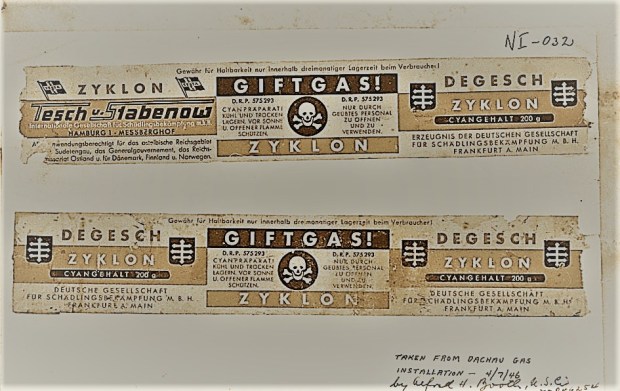
Medical Doctors generally work closely together with Pharmacists. During the Holocaust this was not much different.
Victor Capesius was born to a doctor of German descent in 1907, in a part of Romania which then belonged to the Austro-Hungarian Empire. He studied in Romania and Vienna where, in 1933, he completed his doctorate in pharmacy. In 1943, Capesius was drafted into the German Wehrmacht where he initially served as an “SS pharmacist” in Warsaw. Later, he was transferred to Dachau and on 12 February 1944 he arrived in Auschwitz concentration camp, first as a locum but soon taking the position of chief camp pharmacist,after his predecessor was executed for “spreading defeatism.
Capesius worked closely with Josef Mengele , the pair were heavily involved in the selection of inmates for the gas chamber beginning in the spring of 1944 when the Hungarian and Transylvanian Jews were sent to the camp. He was the only SS selector who was recognized at the arrival ramp by Jews who had known him personally or through his pharmaceutical work before the war.
There are no well-documented links associating Capesius with the pharmaceutical industry during this time, but some documents refer to him as the “Bayer pharmacist in Auschwitz”. The reason for this could be that, in the 1930s, he was the official representative of Farbwerke Bayer-Leverkusen in Romania. Interestingly, Capesius had been reprimanded by his superior during this time for his anti-Jewish attitude and behaviour.
In Auschwitz, he had risen to the rank of SS-Sturmbannführer, in November 1944, and was in charge and control of the poisonous chemicals used in the extermination of the Jews, such as phenol and Zyklon B.

Whilst at Auschwitz, he stole valuables from the personal belongings of arriving Jews, and also secreted away gold pulled from the dental fillings of corpses. He had access to the gold because it was under the control of the camp’s dentists, with whom he shared his pharmaceutical dispensary. Capesius sent the stolen gold to his sister for safekeeping until after the war.
When Auschwitz was evacuated in 1945, Capesius managed to escape. He was caught by the British but released in June 1946. He lived, under his real name, in Stuttgart, only to be again imprisoned in 1946, having been recognised by an ex-inmate of Auschwitz. But, once more, he avoided prosecution. He was freed in 1947 and took employment as a pharmacist in Stuttgart. On 5 October 1950, Capesius opened his own pharmacy in Göppingen, which he opened by using the gold he had stolen from Auschwitz His business (to which he also added a beauty salon) thrived, producing an average yearly turnover of DM 400,000.
A camp survivor, Hermann Langbein, and Germany’s first postwar Jewish prosecutor, Fritz Bauer, were persistent in trying to compile enough evidence to make a case against Capesius. As a result of their work, Capesius was arrested in Göppingen in early December 1959 and remained in custody without bail or bond. On 20 August 1965 he was indicted in the Frankfurt Auschwitz Trials by the Landgericht Frankfurt am Main Community for aiding and abetting the murder of at least four cases of 2,000 people. He was convicted and sentenced to nine years in prison. Capesius served only two and a half years and was released from prison in January 1968.
He died in March 1985 but he never showed any remorse for his crimes..

Donation
I am passionate about my site and I know you all like reading my blogs. I have been doing this at no cost and will continue to do so. All I ask is for a voluntary donation of $2, however if you are not in a position to do so I can fully understand, maybe next time then. Thank you. To donate click on the credit/debit card icon of the card you will use. If you want to donate more then $2 just add a higher number in the box left from the PayPal link. Many thanks.
$2.00
Source
Pharmaceutical Journal
You must be logged in to post a comment.